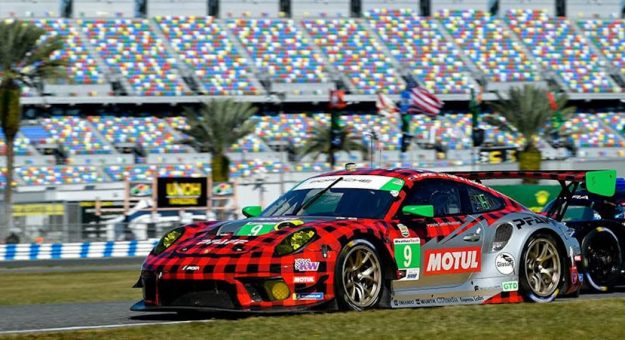DAYTONA BEACH, Fla. — Despite the similarities in looks between the cars in the IMSA WeatherTech SportsCar Championship’s GT Le Mans and the GT Daytona classes, a number of GTLM pilots found just how difficult it is to transition from GTLM to GTD. With the contractions in the GTLM class in recent years, several top GT drivers secured GTD opportunities for last month’s Rolex 24 At Daytona.
The most obvious distinction between the two classes is the Automatic Braking Systems is permitted and standard equipment for most GTD teams. Despite preseason testing, practice, qualifying and several race stints in the Rolex 24, some GTLM veterans running in GTD for the first time were trying to come to grips with ABS.
“For sure, it’s different with ABS,” said Ryan Briscoe, who had six years of GTLM experience and 10 victories in Corvettes and Fords before making his GTD debut driving the No. 63 Scuderia Corsa Ferrari 488 GT3 in this year’s Rolex 24. “It’s definitely a learning experience. All during the race at Daytona I was finding different ways to get a little bit more speed out of it, just because of the ABS. So that was interesting.”
ABS was just the tip of the educational iceberg for Laurens Vanthoor, who made his GTD debut in the No. 9 Pfaff Motorsports Porsche 911 GT3R at Daytona after driving the Porsche GT Team/CORE autosport GTLM entry for three years, winning the class championship in 2019.
“I would say there are two categories of differences between GTLM and GTD,” Vanthoor said. “First is the car, in this case a GT3R (in GTD) and an RSR in GTLM. With the RSR, the engine is in the middle of the car, where in the GT3R the engine is in the traditional position. The GT3R is also a customer car, a couple of percentage points lower in performance. It has ABS, which seems a bit ‘unnatural’ for a race car, so you have to learn how to use it effectively.
“Also, the electronics in the GT3R car are more standard, where in the RSR we were able to adjust everything we wished for our comfort. Tires? In GTLM we had ‘confidential’ tires (specially tailored by Michelin for the performance characteristics of each GTLM marque), where in GTD the tires are standard.”
Beyond the technical aspects of driving the GTD cars, Vanthoor says there’s a different atmosphere.
“The other difference, which I would almost say is bigger, is the environment in GTD. With CORE, it was a full works team with, not really, but you could say an unlimited budget. Every wish that you have to make the car go quicker will be done. Plus, all the people that come with a factory team, all the meetings and responsibilities as well.
“Now it’s a customer car and smaller team; still a top-level team owned by Chris Pfaff. But it’s not like every wish you have on the planet can be done. The team is smaller, there are less meetings and less official things … so life is a bit more relaxed with this team. There’s pros and cons everywhere. Without lying, every driver wants to be with a factory team. But even though the atmosphere is a bit more relaxed now, we’re not here just to drive around. Everyone has the same motivation to win races and win the GTD championship.”
As for the racing, the differences are many. Rather than competing against half a dozen or so cars in GTLM, the GTD newcomers found themselves racing in a class with 19 entries at Daytona. As is custom, GTD cars are piloted by drivers of differing skill levels. While every GTLM driver is a proven professional rated Platinum or Gold, GTD rules require each car’s lineup include at least one driver with less experience and rated Silver or Bronze.
“In GTLM, all the drivers are at a certain level, so you always know where your competition is and where you stand,” Briscoe said. “It doesn’t really matter who’s driving; everyone is within a tenth (of a second) or two of one another. Whereas in GTD, you have all these Silver and Bronze drivers in the mix, where some of them are quick but others are quite a bit off the pace, so it’s difficult to figure out who’s strong and who’s not. It depends on who’s driving. You might be passing a Mercedes-AMG, for example, and you think they’re not too competitive. Then the next stint they’re coming by you and they’re really strong, so it’s a real mixed bag.
“It’s a really hard class to win because the competition is so deep. There are so many cars and drivers, and a lot of very good drivers; as good as anywhere. So it’s kind of a shame that GTD sometimes doesn’t get as much recognition as it should. Yes, they are the slowest cars on the track but it’s super competitive and great racing. In many ways, it’s the toughest class in IMSA to win.”
